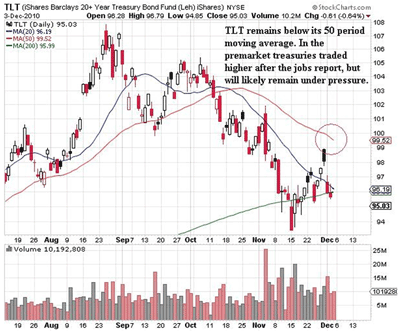The 30-year Treasury bond futures soared after the dismal jobs report last week. While a bounce is likely due to the oversold nature of Treasuries, they remain under their 50-period moving average on the daily chart. As long as the price remains beneath the 50-period moving average, the 30-year Treasury bond will continue to be under selling pressure. If interest rates continue their ascent, eventually it would put downward pressure on the economy, particularly if rates were to move significantly higher in a short period of time. Again, while a bounce at some point is likely, being long Treasuries for more than a trade puts an investor on the wrong side of the price action. Keep a close eye on Treasuries because rising rates will matter at some point.
With the 30-year Treasury bond trading below its 50-period moving average, I thought I would outline a strategy, which does incur significant risk, but offers an excellent income opportunity. While I would never advocate selling or buying options naked for beginners, selling equity-backed puts naked is an excellent strategy to generate income. Additionally, this strategy should be used on an underlying that an options trader would not mind actually owning.
This isn't a typical trade for me or most option traders. However, it is critical for option traders to be aware of all of the trading strategies that options present. The example below is not a recommendation, but simply an example of how this type of trade works and how it can be utilized in a trader's portfolio. First of all, it is critical to realize that Regulation T dictates that option traders require 10%-20% equity to sell a put option naked.
As an example, if the ProShares UltraShort 20+ Year Treasury ETF (TBT) were trading at $35 per share, 100 shares would cost $3,500. To have appropriate equity, an options trader would need as much as $700 in cash to sell one put contract naked. However, those requirements are different among the various options brokers as they typically have varying degrees of margin requirements, which are based on the experience level of the trader and the trader's capital position.
This strategy should only be used on an underlying that an option trader would be willing to own directly. The reason being if an option trader gets assigned he can purchase the stock and potentially start a covered call campaign while he waits for prices to increase. With the 30-year Treasury bond futures being well below their 50-period moving average, owning TBT at a lower price makes sense, particularly when the option trader collects a premium, further reducing the cost of purchasing the common stock.
A general trading rule would be to sell naked puts about five to six weeks before expiration. A trader would want to look for a put option with a delta around 20. In most market conditions, this would give the trader a high degree of probability that the options will expire worthless, producing income for the trader. If possible, using this strategy and incorporating support levels is also warranted. If a strike is near long-term support, selling strikes at a lower price can result in some nice income-producing opportunities and the potential of owning the stock at a much lower price.
If a trader is using this strategy and does not intend to be assigned the stock, stop orders are an absolute must. This strategy does expose itself to overnight risk, but when a put is sold-unlike its cousin the naked call-there is a max loss on each contract. The max loss would take place if the stock were to trade to zero and remain there. While this is highly unlikely, it is theoretically possible.
As stated above, this is a high-risk strategy, but option traders looking to own a specific underlying stock can use this trade construction to further reduce the cost of owning the stock or create additional income for their portfolio. In closing, if managed appropriately, this type of trade can produce some great returns while allowing an option trader the ability to own common stock at a lower price.
By J.W. Jones of OptionsTradingSignals.com






















